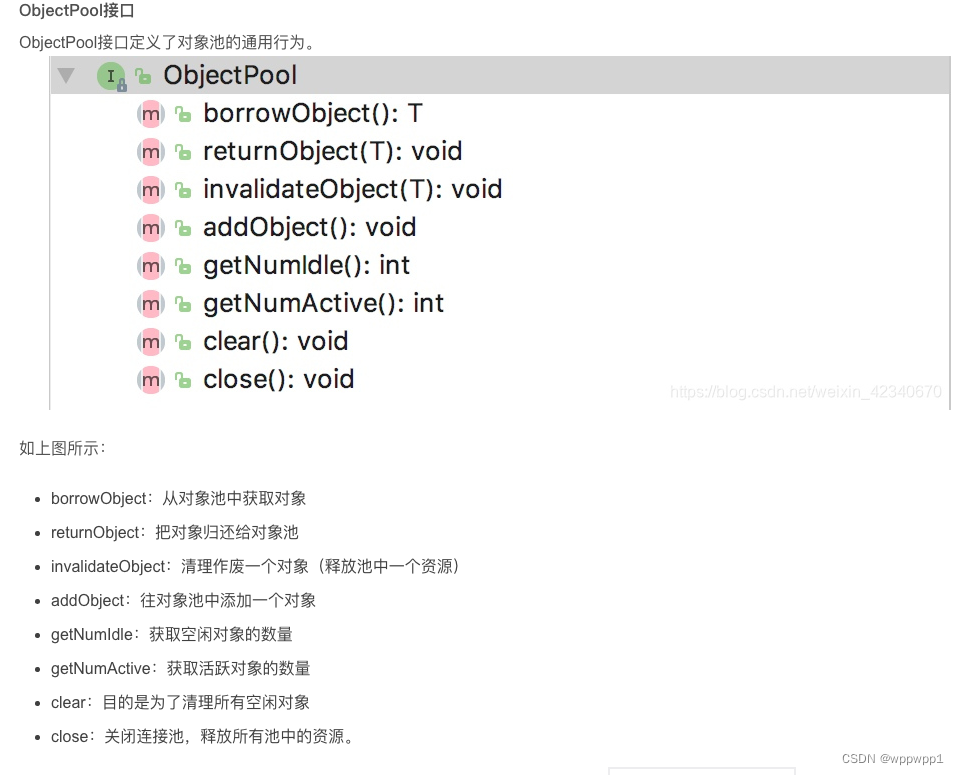common-pool的GenericObjectPool源码创建borrowObject方法研读
发布时间:2023年12月21日
对象池主要管理对象的池,包含借用,归还,添加对象,校验对象是否有效等管理功能

public T borrowObject(final long borrowMaxWaitMillis) throws Exception {
assertOpen();
final AbandonedConfig ac = this.abandonedConfig;
if (ac != null && ac.getRemoveAbandonedOnBorrow() &&
(getNumIdle() < 2) &&
(getNumActive() > getMaxTotal() - 3) ) {
removeAbandoned(ac);
}
PooledObject<T> p = null;
// Get local copy of current config so it is consistent for entire
// method execution
final boolean blockWhenExhausted = getBlockWhenExhausted();
boolean create;
final long waitTime = System.currentTimeMillis();
while (p == null) {
create = false;
p = idleObjects.pollFirst();
if (p == null) {
p = create();
if (p != null) {
create = true;
}
}
if (blockWhenExhausted) {
if (p == null) {
if (borrowMaxWaitMillis < 0) {
p = idleObjects.takeFirst();
} else {
p = idleObjects.pollFirst(borrowMaxWaitMillis,
TimeUnit.MILLISECONDS);
}
}
if (p == null) {
throw new NoSuchElementException(
"Timeout waiting for idle object");
}
} else {
if (p == null) {
throw new NoSuchElementException("Pool exhausted");
}
}
if (!p.allocate()) {
p = null;
}
if (p != null) {
try {
factory.activateObject(p);
} catch (final Exception e) {
try {
destroy(p);
} catch (final Exception e1) {
// Ignore - activation failure is more important
}
p = null;
if (create) {
final NoSuchElementException nsee = new NoSuchElementException(
"Unable to activate object");
nsee.initCause(e);
throw nsee;
}
}
if (p != null && getTestOnBorrow()) {
boolean validate = false;
Throwable validationThrowable = null;
try {
validate = factory.validateObject(p);
} catch (final Throwable t) {
PoolUtils.checkRethrow(t);
validationThrowable = t;
}
if (!validate) {
try {
destroy(p);
destroyedByBorrowValidationCount.incrementAndGet();
} catch (final Exception e) {
// Ignore - validation failure is more important
}
p = null;
if (create) {
final NoSuchElementException nsee = new NoSuchElementException(
"Unable to validate object");
nsee.initCause(validationThrowable);
throw nsee;
}
}
}
}
}
updateStatsBorrow(p, System.currentTimeMillis() - waitTime);
return p.getObject();
}参考引用
对象池(连接池):commons-pool2源码解析:GenericObjectPool的继承结构、构造方法_genericobjectpool idleobjects-CSDN博客
文章来源:https://blog.csdn.net/wppwpp1/article/details/135125970
本文来自互联网用户投稿,该文观点仅代表作者本人,不代表本站立场。本站仅提供信息存储空间服务,不拥有所有权,不承担相关法律责任。 如若内容造成侵权/违法违规/事实不符,请联系我的编程经验分享网邮箱:chenni525@qq.com进行投诉反馈,一经查实,立即删除!
本文来自互联网用户投稿,该文观点仅代表作者本人,不代表本站立场。本站仅提供信息存储空间服务,不拥有所有权,不承担相关法律责任。 如若内容造成侵权/违法违规/事实不符,请联系我的编程经验分享网邮箱:chenni525@qq.com进行投诉反馈,一经查实,立即删除!
最新文章
- Python教程
- 深入理解 MySQL 中的 HAVING 关键字和聚合函数
- Qt之QChar编码(1)
- MyBatis入门基础篇
- 用Python脚本实现FFmpeg批量转换
- 什么是DigiCert?
- GO设计模式——25、模板模式(行为型)
- Mybaits拦截器实现水平分表
- 算法题系列11·找出字符串中第一个匹配项的下标
- Kubernetes的minikube
- 1月研发招聘
- Python 面向对象(类)
- 【Element】el-table 使用 el-table-infinite-scroll 插件实现滚动加载
- ECMAScript日常总结--ES2021(ES12)
- vue3+ts,watch函数监听props数据的使用,以及对immediate和deep属性的作用解释记录